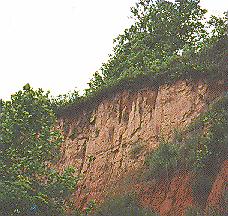
Click image to see closer outcrop of loess.
Hardwood Forest - Forest Soil
In Illinois, forest soils are less productive than prairie soils. Over 400,000 hectares (1 million acres) of forested uplands in Illinois are underlain by light-colored soils known as the Fayette soil series. These well-drained loess soils are slightly acidic and contain little organic matter.
Fayette Series Forest Soil Zones
A. 0–28 centimeters (0 to 11 in.) deep. Dark grey to dark grayish brown silt loam with thin plate-like structure. Roots common near surface but decrease with depth. Medium acid.
B. 28–119 centimeters (11 to 47 in.) deep. Brown to yellow silty clay loam with blocky to prism-shaped structure. Few roots. Strongly acidic.
C. 119–185 centimeters (47 to 73 in.) deep. Yellowish brown silt loam with massive (uniform, with no plate-like or blocky layers) structure and a few dark brown oxide concretions. Strongly acidic.
"Plants interact with soil and influence its characteristics and fertility.
Soils formed under forest plants are lighter in color and less fertile than
prairie soils. Forest leaf litter is acidic, which causes the nutrient-holding
clays and organic matter to be leached out of the soil."